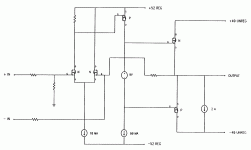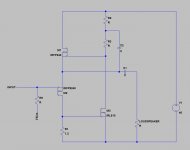Dosnt matter how high the bias starts or how big the caps are. If the signal stays on long enough, a full cd for example, the caps will increase there voltage and increase the bias. The louder it plays the higher the bias goes. What other tricks?
Dosnt matter how high the bias starts or how big the caps are. If the signal stays on long enough, a full cd for example, the caps will increase there voltage and increase the bias. The louder it plays the higher the bias goes. What other tricks?
What circuit does that?
aha
that's why I'm enjoying just first side of CD , with my N2
second side is almost unlistenable

that's why I'm enjoying just first side of CD , with my N2
second side is almost unlistenable

And let's not forget that the nice people at Linear Technology sell an integrated circuit called LT1166, which auto-biases the output stage of an audio power amplifier. (link to document). It can be used with BJT output transistors, or MOSFET output transistors.
Thank you Mark, great tip! Affordable and available in easier to see DIP8. Specified for class AB bias but I see no reason why it can not be used for class A. Typical PassDiy bias of 1.3A will need R sense of 15.38 mΩ which can be 6 parallel of 0.1 Ω resistors or a 0.5 inch length of AWG#26 magnet wire.
In terms of circuitry the LT1166 is more complex.
But it has one big advantage, namely the sense voltage is +/-20mV, instead of ~1.2V for the opto.
Once can argue this is not important for certain designs, such as those with sufficient NFB.
But if one chooses to design an amp with no NFB, then even a bias of 2A would mean Zout > 0.15R, or damping factor < 48.
If we accept +/-0.6V as sense voltage, then the JLH biasing circuit is IMHO just as effective.
It essentially operates on a similar principle.
My personal opinion, of course,
Patrick
But it has one big advantage, namely the sense voltage is +/-20mV, instead of ~1.2V for the opto.
Once can argue this is not important for certain designs, such as those with sufficient NFB.
But if one chooses to design an amp with no NFB, then even a bias of 2A would mean Zout > 0.15R, or damping factor < 48.
If we accept +/-0.6V as sense voltage, then the JLH biasing circuit is IMHO just as effective.
It essentially operates on a similar principle.
My personal opinion, of course,
Patrick
Not against 1.3mV sense at 2A bias required by the ACS723 hall chip.In terms of circuitry the LT1166 is more complex.
But it has one big advantage, namely the sense voltage is +/-20mV, ...
of course , even if I don't like some solution in entirety , there is always something to learn from 🙂
And let's not forget that the nice people at Linear Technology sell an integrated circuit called LT1166, which auto-biases the output stage of an audio power amplifier. (link to document). It can be used with BJT output transistors, or MOSFET output transistors.
I found it very difficult to make it work without oscillation. I invite anyone with
a working example to share it, saving others needless frustration.
Maybe this is of interest to you :
Problem with Bob Cordell's LME49830 and LT1166
Or maybe Bob has some experience also ? 🙂
Patrick
Problem with Bob Cordell's LME49830 and LT1166
Or maybe Bob has some experience also ? 🙂
Patrick
Bob is certainly the guy who would have made it work. I screwed around
with it for a while, and then decided it was too much trouble.
with it for a while, and then decided it was too much trouble.
Amazing that the engineering world keep reinventing itself.
Essentially the JLH auto-bias from 1985 :
RMAF Afterthoughts
Patrick
Essentially the JLH auto-bias from 1985 :
RMAF Afterthoughts
Patrick
This is a neat auto-bias from TubeCAD that I like. (very simplified for clarity)
Class A only, but can have a very low distortion and be very stable and nice behaved. It is easy to add positive current feedback for a negative output impedance if wanted.
Class A only, but can have a very low distortion and be very stable and nice behaved. It is easy to add positive current feedback for a negative output impedance if wanted.
Attachments
- Home
- Amplifiers
- Pass Labs
- Auto-Biasing Circuits for Complementary Followers


